The chameleons of Madagascar.
Chameleon natural habitat.
Chameleon natural habitat is one of nature’s most intriguing wonders. Known for their color-changing abilities, these chameleon reptiles inhabit a wide range of landscapes across Madagascar. Renowned for its biodiversity, Madagascar is home to chameleons with fascinating adaptations, making them uniquely suited to thrive in diverse environments. This article delves into the lives of Madagascar’s chameleons, focusing on their habitats and the specific ecosystems that support three main groups—Calumma, Panther, and Brookesia chameleons.
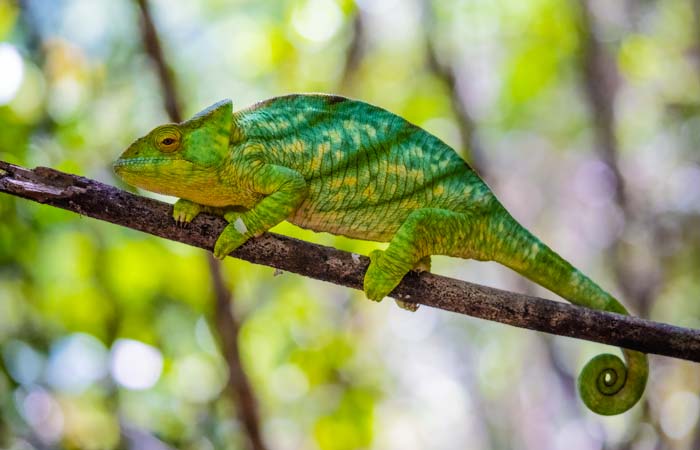
The Enigmatic World of Chameleons
Chameleons, known for their color-changing skills and uniquely structured eyes, have fascinated nature lovers for generations. Each chameleon species has developed particular adaptations to blend into the habitats they call home.
Chameleons in Madagascar
Madagascar stands out as a biodiversity hotspot for chameleons, housing more than 100 species. Its variety of ecosystems—from rainforests to dry forests and highlands—offer the perfect chameleon natural habitat, allowing them to flourish.
Understanding Chameleon Habitats
Chameleons have diverse habitat preferences depending on their species.
- Forests and Woodlands: Lush forests provide camouflage and food sources for chameleons, particularly the Calumma species, which thrives in this dense environment.
- Coastal and Dry Forests: The colorful Panther chameleon prefers these areas, where the climate supports their need for humidity and light.
- Highlands and Mountains: Here, Brookesia chameleons—among the world’s tiniest—blend seamlessly with moss and rocks, illustrating their strong adaptability.
The Calumma Chameleons.
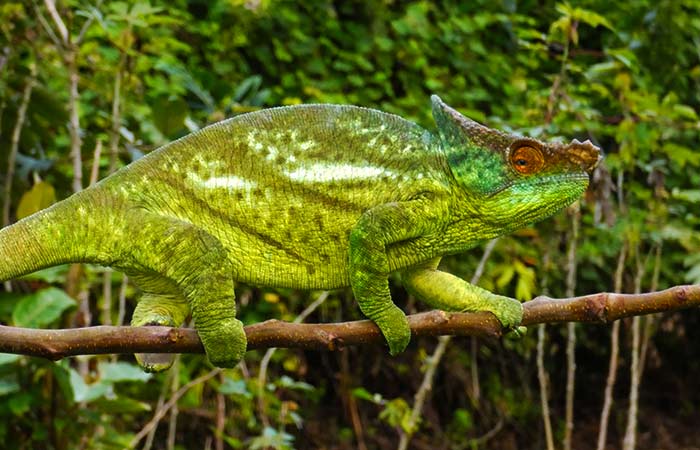
- Overview of the Calumma Genus: Calumma chameleons are exclusive to Madagascar, known for their colorful crests and distinctive patterns.
- Natural Habitat of Calumma Chameleons: Most species thrive in rainforests, such as Andasibe-Vohimana reserve-Ambavanihasina village, where high humidity suits their needs.
Calumma chameleons are a unique genus of chameleon reptiles found exclusively in Madagascar, celebrated for their striking colors, ornate crests, and intricate patterns that help them blend into their natural surroundings. Their chameleon nature habitat typically includes rainforests like Andasibe-Mantadia National Park, where the high humidity and abundant vegetation are perfect for their survival. In these dense forests, they use their incredible camouflage to hunt for insects and evade predators, embodying the harmony between chameleon reptiles and their natural habitat.
The Panther Chameleon: A Vibrant Favorite.

- Introduction to Panther Chameleons: Among the most vibrant chameleon reptiles, the Panther chameleon is beloved for its array of colors, a true highlight in Madagascar’s biodiversity.
- Preferred Environments of Panther Chameleons: Coastal and dry forests offer ideal conditions for Panther chameleons to display their colors and bask in the sun.
The Panther chameleon (Furcifer pardalis) is among the most famous and visually stunning of Madagascar’s chameleon reptiles, celebrated for the rainbow of colors it displays, from bright greens and blues to deep reds and yellows. This vibrant species showcases Madagascar’s biodiversity at its best, attracting both scientists and nature enthusiasts alike. Their chameleon nature habitat in these areas allows them to regulate their body temperature while remaining camouflaged among the foliage, a remarkable adaptation that ensures their success in Madagascar’s diverse landscapes.
Brookesia: The Tiny Chameleons.

- Unique Traits of Brookesia Chameleons: Known as leaf chameleons, Brookesia species are small and adept at blending into the forest floor.
- Habitat of Brookesia Chameleons: Found in highland forests, Brookesia chameleons use leaf litter and mossy surroundings for camouflage.
Brookesia chameleons, often referred to as leaf chameleons, are known for their diminutive size and exceptional camouflage skills, making them one of Madagascar’s most fascinating chameleon reptiles. Unlike their larger relatives, Brookesia species are specialists of the forest floor, where they blend seamlessly with leaf litter, moss, and fallen bark. These tiny chameleons prefer highland and dense forests, where their chameleon nature habitat provides plenty of cover and hiding spots. Their natural habitat allows them to stay hidden from predators while hunting small insects, demonstrating how perfectly their physical and behavioral traits are suited to Madagascar’s forested environments.
Madagascar’s Protected Areas for Chameleons.
Madagascar has dedicated parks and reserves, like Ankarana and Marojejy, Masoala to protect chameleon natural habitats. These areas allow chameleons to thrive without threats from human encroachment.
Chameleon Behavior and Adaptations in Their Habitat.
- Camouflage and Color Changes: Chameleons use color changes to communicate, regulate temperature, and blend into their surroundings.
- Diet and Hunting Techniques: These chameleon reptiles hunt insects with remarkable accuracy, relying on their sticky tongues for quick capture.
Threats to Chameleon Habitats.
- Deforestation and Habitat Loss: Forest clearing for agriculture is a significant threat to chameleon habitats, limiting their safe territories.
- Climate Change Impacts: Changes in temperature and humidity disrupt delicate ecosystems, particularly affecting chameleons with specific environmental needs.
Furcifer Pardalis Antalaha
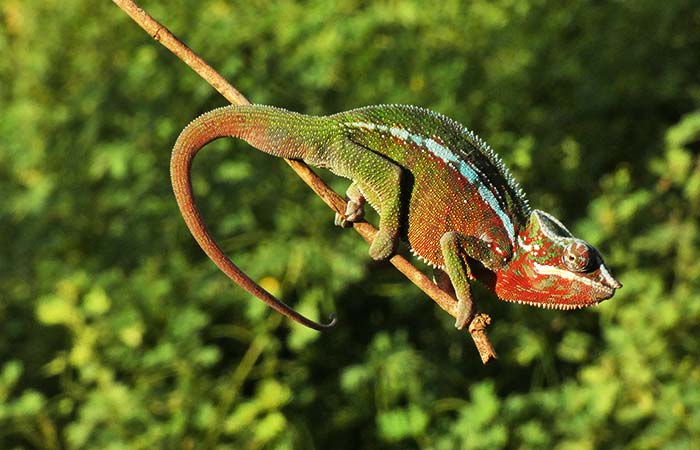
Chameleon Conservation in Madagascar.
Conservation organizations and local communities work together to restore habitats and enforce anti-poaching laws, ensuring a safe future for Madagascar’s chameleons.
How to Spot Chameleons Responsibly.
Eco-friendly wildlife tours are essential for observing chameleons without disturbing their natural habitats. Visitors should avoid handling chameleons and respect their environment.
The Fascination with Chameleons for Enthusiasts.
Chameleon enthusiasts are drawn to these reptiles for their unique abilities and vibrant appearances. As true symbols of Madagascar’s natural wonders, they remind us of the importance of preserving biodiversity.
Madagascar’s chameleons represent an extraordinary example of evolutionary adaptation. Protecting their natural habitats is crucial to maintaining the diversity of chameleon reptiles for future generations.

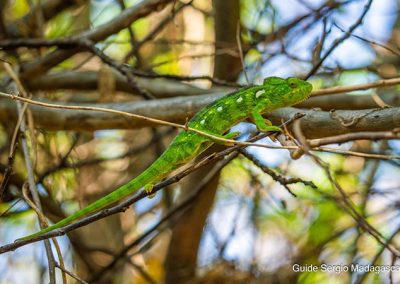
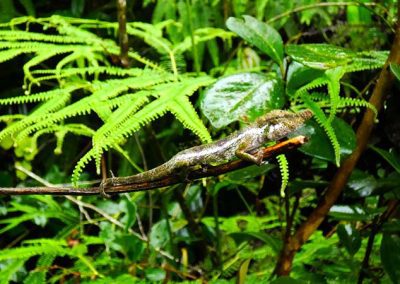
We were incredibly happy with our tour in July/ August 2024! We traveled around the south and west for three wonderful weeks. Sergio is an extremely knowledgeable, passionate and flexible guide. We were so surprised when he pointed out every camouflaged chameleon and tiny creature in the jungles of Madagascar. Somehow, he could easily spot every animal, no matter how hidden, even while driving past on the road- it was unbelievable! He shared many interesting facts and was very professional, while also being open and approachable. He catered to our every need and made sure we were able to see everything we wanted to and even more. His friendliness and joy of his job made our trip extra special. We would highly recommend traveling with Sergio and his team. Thank you for an amazing, unforgettable trip of a lifetime.
Thank you Rebecca & Gino, we did a unforgettable tour.